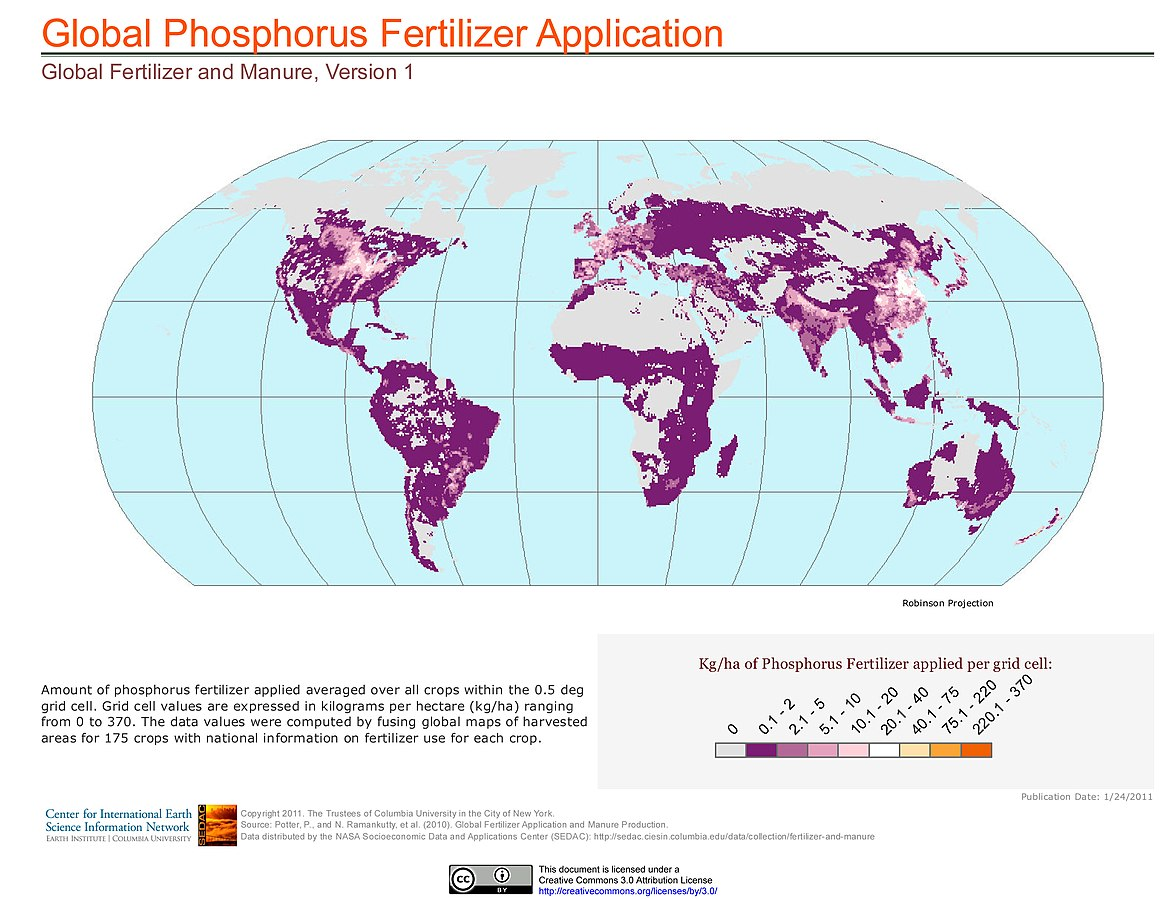The post-World War II Green Revolution helped feed countless people around the world due to the effective use of phosphorus-made fertilizers. Until now pesticides and fertilizers have been nourishing people and meeting the food demand. But an excessive good can quickly turn into excessive greed. Depleting phosphorus beds are one of the outcomes of human greed and are now challenging human survival, Wired Reported
Image Source: Wikimedia
Dependency On Phosphorus
Since the 1800s, agriculturists have known the importance of elemental phosphorus as a fertilizer. Rich nations of the world started mining phosphorus rocks and extracting the mineral.
Naturalists were surprised to encounter the estimates of phosphate consumption between 1950 and 2017. Phosphorus accounted for 50% of soil productivity and was an essential non-renewable mineral for food production. James Elser, an ecologist, was taken aback by the cruciality of Phosphorus and how we take it for granted. According to him, the phosphate rocks were mobilized from their natural mines and moved to different locations of the world, but in the end, they are now a part of anthropogenic (human-made) fertilizer.
In 2008, the global phosphorus rate spiked to 800 percent due to huge demand and supply issues. Due to covid, it spiked up to 400 percent. But even though the soil still has some phosphorous remaining, the mineral access and distribution will be unequal.
Inequity In Phosphorus Distribution
Image Credit: Wikiwand
Josephine Demay, a Ph.D. student at National Research Institute for Agriculture, Food, and the Environment, France, told Wired that Western, Europe, North America, and Asian reliance has jumped to over 60% of the total plant-ready phosphorus in each region. Besides this, Brazil, China, and India have increased their phosphorus consumption to 61, 74, and 67 percent.
On the other side of the picture, the phosphorus deficit in African countries like Zimbabwe uses 20 to 30 percent of minerals. For the whole African region, it is 32 percent on average. Deficient countries encounter unequal distribution of valuable minerals, while rich countries preserve their stock and reserves for decades. These have created a limitation, where wealthier countries are growing in resources, technology, and developments, while some nations are still struggling for a perfect meal in a day.
It further raises a question and concern for future access to the mineral. Who will be the leading supplier, and who will be the foremost purchaser? Even today, almost 75% of the world’s supply backbone is in the regions of Morocco and the Western Sahara.
Unequal access to a mineral has always been a concerning matter for ecologists, where the natural mineral gets confined within the hands of fewer people. Crude oil, for example, is limited to only 13 OPEC countries.
The Broken Phosphorus Cycle
Image Credit: Wikipedia
Humans have already disrupted the Carbon cycle of the earth and, as an outcome, face rising temperatures. Now, scientists are pointing at the broken phosphorus cycle for a decade. But, even as we take measures to fix carbon cycles phosphorus is still not on the radar of problems to fix.
The Phosphorus biogeochemical cycle is the movement of Phosphorus between the biosphere, lithosphere, and hydrosphere. It generally does not include the atmosphere. As a result, it involves both terrestrial and aquatic ecosystems. Phosphorus movement is rapid among living plants and animals but slower in the case of soil and oceans. That is why the P-cycle is the slowest geological process and takes around 20,000 to 100,000 years.
Humans and livestock eat plants and excrete feces that contain phosphorus. It should be used as manure and delivered back to the earth for its healthy phosphorus replenishment. But, in reality, this goes to the sewage treatment plants. There it gets separated as an infiltrate and transferred to the ocean bodies.
Consequences On Water Bodies
Image Credit: Wikimedia
It is a type of water pollution that causes a rapid increase in the algal population, often called an algal bloom. These algal colonies are on the water’s surface and break the connection between aquatic fishes and atmospheric oxygen. This results in the death of aquatic and marine animals due to increased toxicity within the water.
Plants that use this water and animals that drink this water die. Further, it results in decreased dissolved oxygen and increased biochemical oxygen demand. It causes infiltered snow and Water pollution.
What should we do?
Scientists are concerned, as the limited phosphate mineral is slipping from the hands and isn’t getting much time to replenish. Still, we can take some measures to save it for the future as
-
Recycle:- Using feces as manure and reducing water pollution.
-
Preventing soil erosion:- We can grow plants such as mustard and barley that penetrate their roots with the soil and control soil erosion.
-
Urine-diverting toilets:- We can capture phosphorus in liquid form and transfer it to agricultural fields.
-
Struvite:- The addition of magnesium to wastewater can make an alternative to fertilizer.
-
Biotech engineering:- Biotech engineers can create or breed a modified crop. This gene can increase phosphorus absorption and reduce the dependency on fertilizers.
-
Vegetarianism:- This can be the key feature in producing less livestock and reducing the demand for fertilizers to feed the livestock. Another alternative can be lab-grown meat.
The growing demand for phosphorus and the decline in finite sources has become a consideration for ecologists and naturalists worldwide. Elser thinks progress will be developed for agriculture in the coming years. Eventually, phosphorus will reach places with effective mineral recycling.
The research was published in the journal Nature geoscience
Follow us on Medium!






